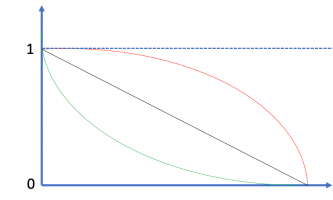jones12345
New member
- Joined
- Jan 19, 2022
- Messages
- 2
Which formulation of equations fits the following behavior, so that a factor decreases from 1 to 0 and they all approach the same x-value in the end?
(1) exponential type decay (green)
(2) linear decrease type (black)
(3) inverse exponential type decay (red)
I think that I have found an expression for the first 2:
(1) y = exp(-b*x), however for small values of b the factor does not approach y = 0
(2) y = -bx + 1
(3) I don't know...
Thanks!

(1) exponential type decay (green)
(2) linear decrease type (black)
(3) inverse exponential type decay (red)
I think that I have found an expression for the first 2:
(1) y = exp(-b*x), however for small values of b the factor does not approach y = 0
(2) y = -bx + 1
(3) I don't know...
Thanks!

Last edited:
